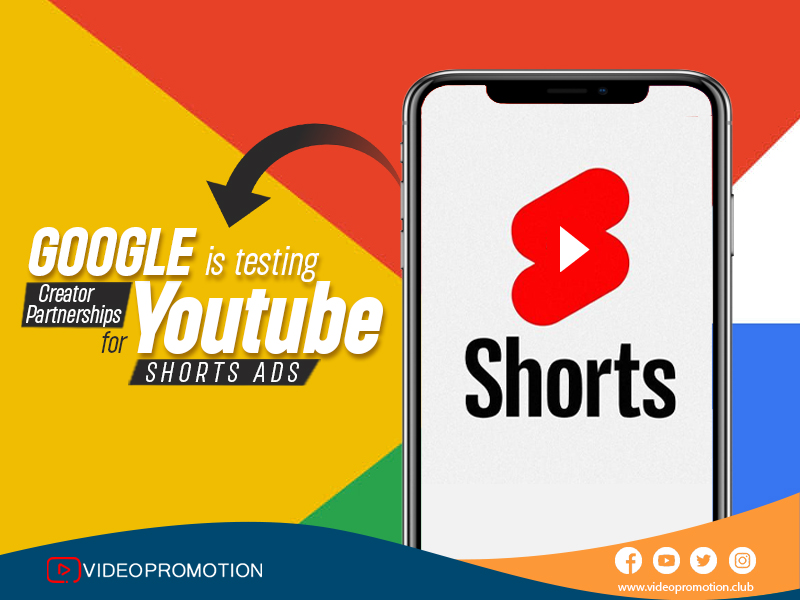

Google is exploring new ways to monetize
YouTube Shorts, and its latest experiment involves creator partnerships for
YouTube Shorts ads. As the popularity of short-form videos continues to grow,
Google is testing a strategy where advertisers collaborate with content
creators to promote brands through Shorts ads. This initiative aims to increase
engagement and provide a new revenue stream for both creators and
advertisers. This blog will explore what this new partnership model means,
how it works, and its potential impact on the YouTube ecosystem.
What
Is Google’s New Creator Partnership Model for Shorts Ads?
Google’s new test focuses on collaborations
between creators and brands to promote ads through YouTube Shorts. Instead of
relying solely on traditional ads placed between Shorts, Google is
experimenting with a model where creators integrate brand promotions directly
into their Shorts content.
Understanding
YouTube Shorts and Its Growth
YouTube Shorts, Google’s response to TikTok
and Instagram Reels, was launched globally in 2021. These 60-second vertical
videos gained immense popularity, and by 2024, YouTube Shorts were generating
over 50 billion daily views. As Shorts became a dominant format, monetizing
this content became a challenge. Unlike longer videos where mid-roll ads
generate revenue, Shorts operate differently. To address this, YouTube
introduced the Shorts Partner Program in 2023, allowing creators to earn ad
revenue from Shorts. However, ad revenue from Shorts was initially limited,
leading Google to explore new models to maximize earnings for both creators and
the platform.
How
the Partnership Model Works
Brands partner with popular Shorts creators
to create engaging and organic content that promotes their products or
services. This content feels less like a traditional ad and more like native
content, increasing the likelihood of engagement. Creators incorporate the
brand’s message, product, or service into their Shorts naturally and
authentically. This could be through product demos, unboxings, reviews, or
creative storytelling. Revenue generated from these partnerships is
shared between the creator and YouTube. Creators get a portion of the ad
revenue, similar to traditional brand deals, but with YouTube acting as the
facilitator. Since these ads are integrated into the content itself, they
are more likely to hold the viewer’s attention, leading to higher ad engagement
and conversion rates.
How
the Google’s New Creator Partnership Model Affects YouTube Creators
For creators, this new model presents an
opportunity to boost earnings while maintaining creative freedom. YouTube’s
traditional revenue-sharing model from Shorts often leaves creators with lower
earnings due to the nature of ad placements. This partnership model allows
creators to earn additional income through direct brand collaborations.
Benefits
for Creators:
Creators can earn significantly more by
collaborating with brands for in-video promotions compared to standard ad
revenue from Shorts. Creators maintain full control over their content
while integrating brand promotions in a way that feels authentic to their
audience. These partnerships enable creators to build long-term
relationships with brands, opening the door to future sponsorships and
collaborations. Since native promotions feel less like ads, creators are
likely to maintain audience trust and engagement while earning from sponsored
content.
Advantages
for Brands:
When a trusted creator promotes a product,
viewers are more likely to trust the recommendation, leading to higher
conversion rates. Brands can collaborate with creators whose audience
aligns with their target market, ensuring that promotions reach the right
people. Compared to traditional advertising, partnering with creators for
Shorts ads can be more cost-effective while delivering higher
engagement. Brands can measure the performance of these partnerships
through detailed analytics, helping them fine-tune their marketing
strategies.
Key
Reasons Why Google is Exploring This Model:
Integrated ads within a creator’s content
feel more authentic and are less intrusive compared to pre-roll or mid-roll
ads. Viewers are more likely to engage with a product when it’s presented by a
creator they trust. Many creators on
Shorts struggle to earn substantial income compared to long-form video
creators. This model offers additional revenue streams through brand deals
facilitated by YouTube. When a creator recommends a product or
service, it tends to generate higher trust and conversions than traditional
ads. This partnership model can significantly improve ad performance for
brands. Native promotions within Shorts reduce the likelihood of ad
fatigue. Since the promotions blend with the content, viewers are less likely
to skip or disengage.
Challenges
and Concerns:
While this partnership model offers many
benefits, it also comes with potential challenges. One major concern is
ensuring that creators maintain authenticity when promoting brands. Overly
promotional content may lead to viewer skepticism and loss of
trust. Creators need to strike a balance between sponsored content and
organic videos to avoid alienating their audience. Too much promotional content
can lead to disengagement. Ensuring fair revenue sharing between creators,
brands, and YouTube is essential for the success of this model. If creators
feel underpaid, they may lose interest in participating. Creators must
clearly disclose sponsored content to comply with advertising guidelines and
regulations, ensuring transparency for viewers.
Potential
Long-Term Effects:
Creators will no longer have to rely solely
on ad revenue and can diversify their income through brand partnerships. Viewers
will experience less intrusive advertising and more engaging content that feels
natural and relevant. The partnership model can strengthen the
relationship between creators and brands, leading to long-term
collaborations. As revenue potential increases, creators may invest more
time and effort into producing high-quality Shorts.
Google is creating a win-win situation
where creators earn more, brands get better exposure, and viewers experience
more authentic content. While there are challenges to address, this model
holds great promise for the future of Shorts and has the potential to reshape
the advertising landscape on YouTube. Several promotional companies like Video
Promotion Club can help their clients through this new model. If this
experiment proves successful, it could pave the way for a new era of content
monetization on YouTube Shorts, benefiting creators, advertisers, and viewers
alike.
Comments
Leave A Reply